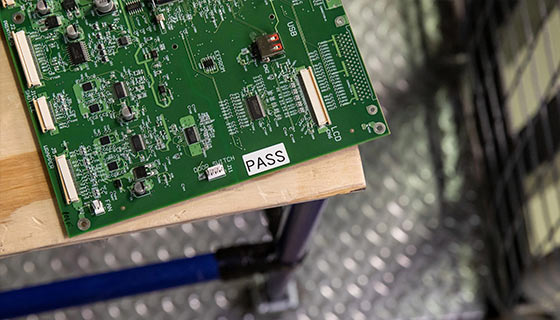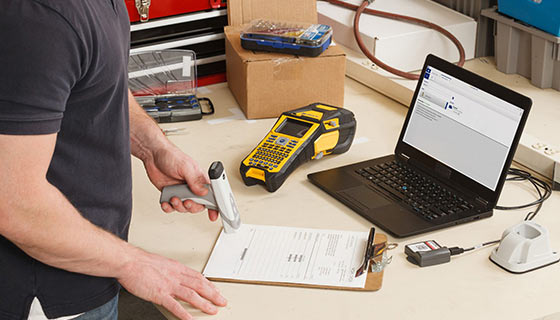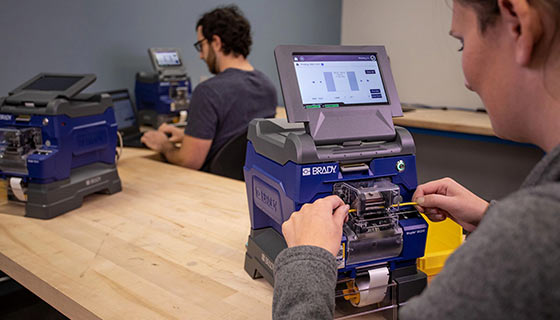Labels for Safety, Visuals and Facility ID Desktop Printers
Labels for Product, Wire and Lab ID Benchtop Printers
Labels for Safety, Visuals and Facility ID Desktop Printers
Labels for Product, Wire and Lab ID Benchtop Printers
Safety and Facility ID Desktop Printers
Product, Wire and Lab ID Benchtop Printers
Barcode Scanner and Printer Kits
Barcode Scanner and Printer Kits
PaintStripe Floor Marking Stencils
Valve Lockouts & Hose Lockouts
Group Lock Boxes & Permit Control
Brady Safety Lockout Tagout Services
Pipe Marker Accessories & Mounting Brackets
Maintenance and Production Tags
Calculators and Assessment Tools
Product Finders and Data Sheets
Manufacturing. It’s a key component of our economy. In fact, as of 2019, manufacturing accounted for approximately 11% of the U.S. GDP. Because this industry is so essential, there is constant pressure to increase efficiency and safety while reducing costs, and technological upgrades such as automation play an important role in making this happen. Automation has been implemented at virtually every phase of production as a means of improving precision and efficiency—but how can you make it work for you?
The first phase of production for many manufacturing entities is the processing of raw materials. Because this often constitutes a fairly repetitive process, it can be relatively simple to automate. Machinery can simply be programmed to repeatedly perform an action. For example, a computer technology company may automate the production of raw materials by programming machines to melt and transfer metal into molds to create computer parts. Such small and complex components must be produced exactly the same way every time, which makes this an ideal task for automation.
Numerical control (NC) machines are not new. They are effectively the impetus for automation in the manufacturing industry, and the fact that they are still in use today speaks to their value. Typically, manufacturers now use computer numerical control (CNC machines), which host a standard numerical control system that is managed through a computer interface.
Following the production and processing of raw materials, CNC machines can be used to make any further adjustments. For example, building upon our previous example of computer parts, a CNC machine may be used to precisely grind structures into items such as computer chips. As other forms of technology become smaller and more precise, the abilities of CNC machines are also updated to make extremely exact adjustments to materials.

Assembly lines are another area where automation has already long been in use, as the purpose of an assembly line is to produce items as efficiently and consistently as possible. Machines on these lines can simply be programmed to repeatedly perform the same action. As technology expands, the capabilities of automated assembly line machinery expand with it.
Automation is particularly helpful as it concerns small or delicate adjustments, as well as precise measurements. It can also be used as a means of reducing fatigue in workers for tasks that are repetitive or would require a lot of strain, such as repeated lifting or applying labels. For these reasons, the automotive industry has long led the pack in terms of assembly line automation, as production in that industry requires precision in the assembly process. More often than not, automated mechanisms in automotive production facilities both assemble smaller parts such as motors and pumps, and handle larger installations such as fitting the windshield.

Robotic arms with fixed programming have long been a staple of factory assembly lines. However, the style and capabilities of manufacturing robots are in constant development. For example, Flex Tracks are now used in many areas of aerospace manufacturing. This technology allows robots to effectively “crawl” around the aircraft to make adjustments.
Collaborative robots that utilize machine learning are also being developed to identify and efficiently work with human employees. For example, an automated forklift may identify a person in its path and take steps to avoid them, or a system tied to a portable label maker could direct a human worker to a specific item in the inventory. Many robots can also perform review functions, such as ensuring that items meet quality standards and are properly labeled.
Computer-aided design (CAD) is a valuable component of the manufacturing process because it allows developers to better visualize the eventual end product. Automated CAD systems are sometimes referred to as CAutoD, which typically take a prototypical concept and then automatically adjust that design to maximize structural integrity, functionality and any other applicable variables.
CAutoD is often used in civil engineering and architectural construction, as there are many variables to account for, repeated adjustments that need to be made and a heightened obligation on the part of designers to maximize the safety and longevity of structures. For example, CAutoD software may be applied to tasks such as framing to ensure that load-bearing structures support distributed weight as evenly as possible.
Nesting software is used to reduce material waste during the manufacturing process by preparing and strategically cutting raw materials so little of the material goes unused. Algorithms can now be paired with this software that allows it to analyze the desired shape of the project and use that information to calculate the best strategy for cutting the raw materials. Such algorithms may also feature attributes such as the ability to identify any imperfections in the raw material. This application of automation can be utilized in any manufacturing setting where raw materials need to be cut efficiently. However, it is particularly common in settings where sheet metal needs to be reshaped.
Manufacturers need to be able to seamlessly collaborate with other actors in the supply chain, and these other business entities may use different software and different protocols. While it is helpful to integrate software efforts with your close collaborators as much as possible, this can be a daunting task.
Automation can be a helpful solution. Software can be optimized to do things like update simultaneously throughout the supply chain, and automated machinery and systems in different facilities can even be programmed to communicate with each other to operate more efficiently. For example, machinery in one location may update their procedures automatically when a design is updated through a CAD program in another facility, or an update in labeling procedure may result in the automated update of labels throughout the supply chain.
While automation is helpful in many areas of manufacturing, if you’re considering automating any area of production, you should first assess the unique needs of your business and the resources at your disposal. Although automation can ultimately result in significant savings and value, initially, some automation upgrades are very expensive and require a lot of training to utilize. Savvy manufacturers should not let themselves get left in the dust from a technological standpoint, but it is often a good idea to make such updates gradually, with a focus on areas that bring you the most reward for the changes you make.
